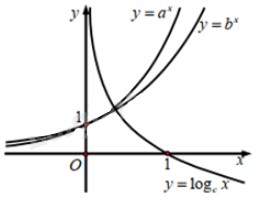Vỏ Trái Đất ở đại dương có độ dày là bao nhiêu?
Hãy suy nghĩ và trả lời câu hỏi trước khi xem đáp án
Đáp án C
Vỏ Trái Đất là lớp vật chất cứng ngoài cùng của Trái Đất, độ dày dao động từ 5 km (ở đại dương) đến 70 km (ở lục địa). Căn cứ vào sự khác nhau về thành phần cấu tạo và độ dày, vỏ Trái Đất được chia thành hai kiểu chính: vỏ lục địa và vỏ đại dương.
Câu hỏi liên quan
Cho tập hợp A = {x ∈ ℤ | (x2 – 4)(x2 – 4x + 3) = 0}.
Viết tập hợp A dưới dạng liệt kê các phần tử ta được:
Các đại lượng lôgic chỉ nhận giá trị "Đúng" hoặc "Sai", được thể hiện bằng?
Cho đồ thị các hàm số \(y = {a^x},y = {b^x},y = {\log _c}x\) như hình vẽ:

Khẳng định nào dưới đây là đúng?
Lệnh nào sau đây xoá toàn bộ danh sách?
Trong giao diện chỉnh sửa video, thành phần nào chứa các lệnh như sao chép, xoá và các lệnh căn chỉnh đối tượng khác?
Cáccấp độ tổ chức của thế giới sống là
Khi phân tích một hợp chất, người ta phát hiện thấy hợp chất này có 6 nguyên tử carbon và tỉ lệ các nguyên tử carbon, hydrogen, oxygen là 1 : 2 : 1.
Lớp Số electron tối đa K L M N Thị trường bao gồm những yếu tố cơ bản nào?
Trong chương trình Công nghệ 12, giới thiệu loại mạch chỉnh lưu nào?
Sử học và các ngành khoa học xã hội và nhân văn có mối quan hệ như thế nào?
Điểm khác biệt cơ bản giữa nhiệm vụ của cách mạng tư sản Pháp cuối thế kỉ XVIII với các cuộc cách mạng tư sản trước đó là gì?
Quá trình chuyển biến từ vượn thành người nhờ tính chất chuyển tiếp trung gian là:
Thông tin khi đưa vào máy tính, chúng đều được biến đổi thành dạng chung nào?
Khối lượng phân tử (g) của phân tử Cl2 bằng bao nhiêu? Biết mỗi nguyên tử chlorine có 17 proton, 18 neutron và 17 electron và mp =1,6726.10-27kg, mn = 1,6748.10-27kg và me = 9,1094.10-31kg.
Read the following passage about the impact of social media on mental health and mark the letter A, B, C, or D on your answer sheet to indicate the best answer to each of the following questions
[I] In recent years, social media platforms have become a central part of daily life, offering users countless ways to connect, share, and communicate. [II] While these platforms offer many advantages, experts have noted rising concerns about their effects on mental health, particularly among young people (Smith & Anderson, 2018). [III] Studies reveal that excessive social media use can contribute to feelings of anxiety, depression, and loneliness, despite its intention to promote connection and social interaction (Twenge & Campbell, 2019). [IV]
A primary reason for these mental health concerns is the tendency for social media users to compare themselves to others. Platforms like Instagram and Facebook often highlight idealized lifestyles, leading users to feel inadequate about their own lives. Additionally, the constant notifications and messages contribute to a "fear of missing out," or FOMO, which keeps individuals in a cycle of checking their phones, often reducing the quality of sleep and overall well-being.
There is also a growing body of research suggesting a link between social media use and decreased attention spans. When users frequently switch between apps and notifications, their ability to focus for extended periods may diminish (Rosen, 2019). This shift in attention can interfere with productivity, especially in academic and professional settings, where sustained focus is essential.
Addressing these challenges requires a multi-faceted approach. Some mental health professionals suggest limiting screen time and setting boundaries, such as "device-free" hours before bedtime. Others recommend engaging in offline activities, like reading or exercising, to reduce dependence on social media and build healthier habits. According to psychologists, such strategies can bu mental resilience and allow for more meaningful, balanced relationships (Robinson & Smith, 2020).
Which of the following is TRUE according to the passage?
Nguyên tử nguyên tố X có tổng electron s là 5. Số hiệu nguyên tử của X là
Thao tác nào dưới đây có thể gây mất an toàn khi sử dụng thiết bị thí nghiệm Vật lí?
Theo em, vì sao chúng ta cần tiêu dùng hợp lí và có kế hoạch?
Read the following leaflet and mark the letter A, B, C, or D on your answer sheet to indicate the option that best fits each of the numbered blanks from 7 to 12.
Here are some ways to help reduce global warming. Which of these do you regularly do?
Don't use private cars. Your willingness to walk or cycle to nearby places can help reduce the emissions of carbon dioxide and also reduce your own carbon footprint. Use public transport. If travelling long distances, then use public transport rather than your car. However, if you carpool (travel together with a group of people in one car), then you are choosing to help ___(7)___ environment. If we travel with ___(8)___, we will use less petrol.
Make a decision to reduce, recycle, and reuse. Reduce waste by buying reusable products. Don't forget to recycle plastics, glass, and paper products. You may wish to reuse some of your old items to ___(9)___, too. Take unneeded ___(10)___ to a recycling centre.
Buy local goods. When you buy goods ___(11)___ from far-away places, it takes a lot of energy to ___(12)___ them to your area. This means that if you don't buy local food and products, then more emissions of carbon dioxide will happen during the transportation process.
(Adapted from English Discovery)















